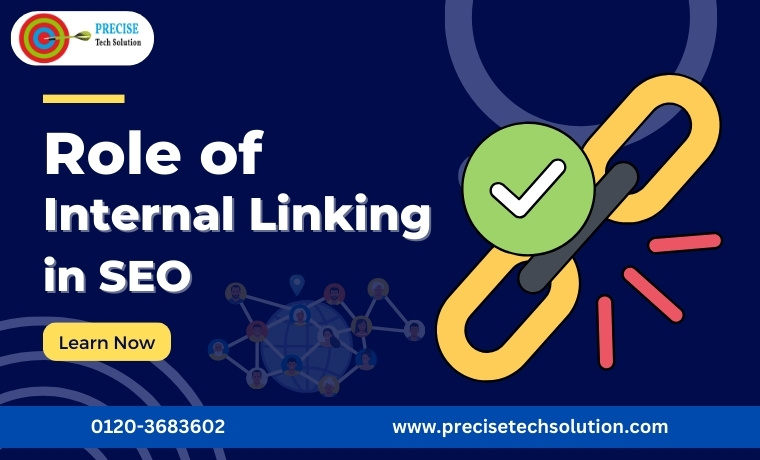What is Internal Linking in SEO?
The process of including hyperlinks pointing to other web pages on the same website within the text of a website or web page is known as internal linking. These links are used to bring together various pages and sections of a website, forming a web of connected content. The visible, clickable text that users view that is used to generate internal links is known as anchor text.
Therefore, it’s crucial to utilize anchor text that appropriately represents the content of the linked page when developing internal links. This makes it easier for both consumers and search engines to grasp the link’s context. Additionally, rationally organizing your internal linking structure helps enhance SEO and user experience.
In this blog post, we’ll look at the significance of internal linking in optimizing the rank of websites via SEO on major search engines like Google, Bing, Yahoo etc.
Table of contents
- Why Internal Linking is Important in SEO?
- What are the best practices to implement Internal Linking in SEO?
Why Internal Linking is Important in SEO?
Internal Linking plays an important role in SEO (Search Engine Optimization) due to the following reasons:
Internal links make it easier for search engine crawlers to identify and index every page on your website. These links enable search engines to efficiently navigate your site’s content and comprehend its organisation. This is especially crucial for big websites or pages with intricate structures.
Search engines can learn which pages you believe to be valuable and deserving of indexing by following links from other relevant pages to essential pages. By doing this, you can make sure that the search engine results reflect your most significant content accurately.
Internal links can transfer authority or “link juice” from one page to another. Some of the authority from pages with high authority can be transferred to other pages on your website. This might elevate the position of related pages in search results.
Search engines can understand the subject and context of the linked page by reading internal anchor text that contains pertinent keywords. This will increase your chances of ranking for certain keywords by assisting search engines in determining how relevant your content is to them.
By leading users to relevant or related content, strategically placed internal links can improve the user experience. As a result, users may stay on your website for longer periods of time, which sends a good signal to search engines.
You can link deep or infrequently accessed pages to more well-known or prominent pages by using internal linking. This might assist in highlighting important content that could otherwise go missed by users and search engines.
You may give your content a logical, hierarchical structure by using internal linking. This makes it simpler for both visitors and search engines to comprehend the relationships and organizational structure between the many pages on your website.
What are the best practices to implement Internal Linking in SEO?
To guarantee that your website’s user experience and SEO are optimized, using internal links properly requires adhering to a few best practices. Following are some essential internal linking best practices:
Use Descriptive Anchor Text: Select anchor text that precisely summarizes the information on the linked page and be careful not to use clichés like “click here” or “read more.” Users and search engines can understand the context of the linked content thanks to descriptive anchor text.
Linking to Relevant Content: Internal links should join related or pertinent stuff together. Link to posts that go into more detail, address a particular issue, or address associated problems.
Prioritize User Experience: Users should understand the internal linking on your website. Think about how they will navigate your website and how you might direct them to the most useful and pertinent content.
Avoid Unnecessary Overlinking: Limit the number of internal links on one page as the link’s authority or “link juice” can be diluted if there are too many of them, which can also mislead users. Instead, concentrate on relevance and quality.
Link from High Authority Pages: Links to pages that require a boost should, whenever possible, come from pages with greater authority. As a result, the linked pages may receive some of the authority and possibly rank higher.
Use a Logical Structure: Create a logical and hierarchical organisation for your internal links. Use sections, subsections, and categories to help readers navigate your content.
Link to Pillar and Clutter Pages: Think about producing pillar content comprehensive, in-depth content and cluster content supporting articles and linking them together. As a result, SEO is improved, and your website becomes recognised as an authority on the subject.
Audit and Update Links on a Routine Basis: Make sure the internal links on your website are still relevant and working by periodically reviewing them. The user experience and SEO may suffer from outdated or broken links.
Link from Body of Content: Put internal links in the body of your material when the situation calls for them. If you do this instead of just putting them in sidebars or footers, it will look more natural and user-friendly.
Diversify Anchor Text: Make use of various anchor texts that highlight various facets of the content you are linking to. This can provide search engines a more thorough knowledge of the subject of the linked page.
Use Tools for Analysis: Insights into how users engage with your internal links can be obtained using tools like Google Analytics and Google Search Console. To improve your internal connection strategy, analyse this data.
Consider User Demographics: Identify the user demographics and how your internal links can help them find what they’re looking for. User engagement and satisfaction are increased as a result.
Link to Evergreen Content: Linking to evergreen information that is still useful in the future should be prioritised. This guarantees that both users and search engines will continue to value the connected content.
Balance B/w External and Internal Links: Incorporate external connections to reliable sources together with internal ones, which are crucial. This can increase the credibility and value of your content.
Maintaining a Mobile-Friendly Experience: Make sure your internal links are simple to click and navigate on mobile devices, taking touch screen interactions into consideration.
By adhering to these best recommended practices, you can develop an internal linking strategy that is well-organized and beneficial to both your website’s users and search engine optimisation efforts.
What are the tools that can be used for Interlinking in SEO?
There are several tools available to help you optimise your internal linking strategy. To assist you in developing a strong internal linking structure, these following lists of tools can offer analysis, insights, and ideas:
Google Search Console: This Google tool is available for free and offers useful information about internal links along with details about how your site appears in search results. It can reveal the most frequently linked-to pages, how frequently Google crawls them, and whether there are any crawl issues.
Google Analytics: Google Analytics, while largely intended for monitoring user behaviour and website performance, can also provide information about how users engage with your internal links. To find areas for improvement, you might examine bounce rates, time on page, and travel pathways.
SEMrush: Internal linking analysis and optimisation tools are available in SEMrush, a complete SEO package. Internal linking problems, broken links, and ideas for changes can all be found using its site audit tool.
Ahrefs: Another effective SEO tool, Ahrefs, includes options for internal linking analysis as well as insights into the backlink profile of your website. The Ahrefs Site Audit tool may be used to find broken links, examine your internal link structure, and receive optimisation advice.
Screaming Fog SEO Spider: This desktop tool can crawl your website and provide a thorough analysis of the internal links, anchor text, and other SEO-related components. It’s an excellent tool for locating problems and chances for internal linking development.
Yoast SEO Plugin: The Yoast SEO plugin, if your website is powered by WordPress, can aid with internal linking optimisation. As you create new articles, it analyses your content and offers pertinent internal links.
Link Whisper: You can optimise your internal links with the aid of this WordPress plugin. As you type, it offers pertinent internal links and aids in visualising the internal linking scheme of your website.
Crazy Egg: It can offer insights into how readers engage with your content while being mostly renowned for heatmap and user behaviour research, which can assist you determine where internal links could be most useful.
Ryte: An internal link analysis tool is one of the SEO tools Ryte provides. You can use it to identify pages with poor internal link structures and receive suggestions for improvement.
Apart from these above-mentioned tools, Internal link management and optimisation can be facilitated by the built-in tools or plugins available on many contemporary the content management system (CMS) platforms, including WordPress, Drupal, and Joomla.
Conclusion
Hence, from the above discussion, we can conclude this blog post by saying that the search engine rankings of your website can be greatly boosted by using a well-planned internal linking strategy. You may boost your search engine rankings, generate organic traffic, and establish a more credible online presence by incorporating these concepts into your internal linking strategy and carefully considering user experience and content relevance. Although internal linking is a potent tool, it should be a small element of a larger SEO plan that includes useful keywords, high-quality content, and a website with an intuitive design.
Contact Precise Tech Solution if you feel the need to work on both SEO and making internal links but are unsure on where to begin with. We are a group of technical experts with extensive knowledge of digital marketing. You may expand your consumer base, raise brand awareness, and enhance organic traffic with the aid of our carefully chosen content strategy.
For more information, visit our website at www.precisetechsolution.com or call our office @ 0120-3683602.
Also, you can send us an email at info@precisetechsolution.com
We look forward to helping you!


